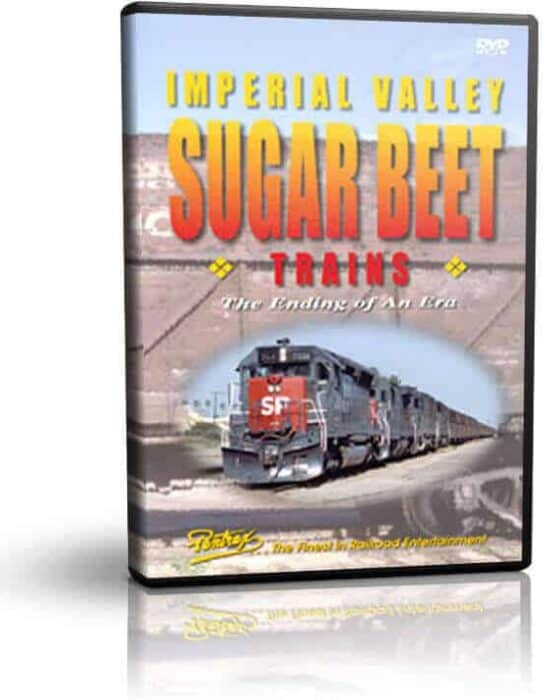Imperial Valley Sugar Beet Trains
SKU: DVD-PNX-VR074Original price was: $29.95.$24.95Current price is: $24.95.
Southern Pacific’s last Imperial Valley sugar beet train pulled into the station at Guadalupe, California in 1993 – the nearby sugar mill would shut down after nearly 100 years of operation. Catch the last run of the famous sugar beet train.
In stock
- Free Post Office shipping over $25!
- Free UPS shipping over $75!
| Producer | Pentrex |
|---|---|
| Run Time | 1 hour |
| Narration | Yes |
| Shrink Wrap | Yes, Brand New |
| Technical Details | NTSC, Region Free, View Worldwide on Computer |
In the early hours of July 17, 1993, Southern Pacific’s last sugar beet train from the Imperial Valley pulled into the station at Guadalupe, California. The nearby sugar mill would soon be shut down after nearly 100 years of operation and SP’s sugar beet trains, with their familiar wooden gondolas, would no longer make the run from the southeast corner of the state to the central coast. Video Rails was on hand to record this historic moment, for they were capturing the entire sugar beet operation prior to the end of an era.
Our journey begins in the lush farmlands of the Imperial Valley, 420 rail miles away from the Holly Sugar Mill at Betteravia. There you’ll watch as sugar beets are harvested, transported to receiving stations, and then loaded into the wooden gondolas, with their friction bearing axles, that made SP’s unit beet trains so unique. The loaded trains of up to 100 steel and wooden cars hauling 10,000 tons of sugar beets depart El Centro, heading toward Taylor Junction in L.A. and along the Coast Line to their destination in the Santa Maria Valley. Helper units are often added for the push over Beaumont Hill, as you’ll see on several of the trains.
At Taylor Junction, we’re invited into the cab of SD40 7349 on the point of a 3-unit lashup that includes two SD45s. The cab ride to Guadalupe features tunnels, cuts, and blue Pacific Ocean views as well as meets and passes with intermodal hotshots and Amtrak trains. At the interchange yard in Guadalupe, the Santa Maria Valley Railroad’s new GP9 arrives to transfer the gondolas to the Holly Sugar Mill. Then we’re treated to a complete tour of the refining process, from unloading to washing, pulping, purifying, drying, and bagging the granulated sugar. Though the mill has since been partially demolished and SP’s sugar beet trains are a thing of the past, you can still enjoy one of the most interesting railroading stories ever shown, now on DVD from Pentrex.



Curtis Watson –
This program covers the end of unit sugar beet trains between El Centro and Betteravia, CA. Beets are harvested, weighed, and loaded into old wooden “beet gons” for a trip over Beaumont Hill and up the coast line to interchange with the Santa Maria Valley Railroad, which services the Holly Sugar plant. Unfortunately, everything we see here would come to an end very shortly. Thankfully, we’re provided with excellent coverage of some of the last of the sugar beet trains!
Dan –
Railfan video? History lesson? Industrial film? “Yes”, to all of the above! Everything about “Imperial Valley Sugar Beet Trains” is interesting and informative, from the detailed look at the process of making sugar (from the ground up, literally) to the SP locomotives, the unique freight cars, the cab ride, the setting — you’ll be surprised at how many times you find yourself saying “I didn’t know that” or “I remember that”! This is one of those programs that just gets better with time, and you don’t even have to be a train fan to enjoy it!
rickyfreni –
Filmed in Mid-July of 1993, the SP has closed its books to say goodbye to hauling sugar beet cars due to the FRA rules on the Friction Bearing trucks going away for scrap as well as the old wooden cars. A tour of the 2 Sugar beet plants are included.
rrvideoman, Delisle Saskatchewan. –
A very interesting movie. Whether you are a farmer, a tourist, a rail fan, a fan of food production, etc… There is something of interest in this movie. The making of sugar is complex, and the movie producer shows all the stages from the field to the plant to the bag. Most interesting as to how everything thing is covered. Being a farmer for many years, I am able to place myself in the field during the harvest. Enjoyed seeing a Southern California cattle farm. As a railfan, watching the loading, transportation, and unloading brought the trains to life. The processing of the sugar was an eye opener. Few people realize exactly what’s involved. This movie shows it all. Only note that I thought could have been added was: What happens to the left over product (the beet pulp) that is not made into sugar? (My son asked me at the end of the movie). There is no showing of any products leaving the plant. The beet pulp is dried down and returned to many farms as a high protien feed additive for livestock, amoungst other products that it can be made into. An excellent presentation of a topic that most people take for granted. High marks for Video Rails and Pentrex for bringing us this movie.